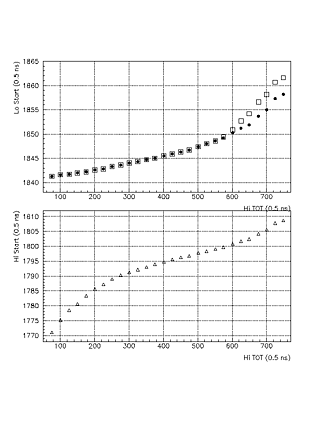
This mini-report addresses Cy's concern about the
choice of the high tot which is currently being used as the criterion for
switching to using the high start instead of the low start of the shower
data. This switch from the low start to the high start is necessary to
minimize the effect of prepulsing
on the start times. The idea is to keep on using the low start of a pmt
signal for reconstructing showers until the number of PEs seen by the pmt
is large enough for prepulsing to set in, at which point one has to use
the high start instead. The high tot cutoff
at which this switch is made is determined from the laser
calibration data. Cy is concerned about the
choice of this high tot cutoff for each pmt, and understandably so. Before
I elucidate some more on what's bugging Cy, an explanation of how the high
tot cutoff is chosen is probably useful.
When one plots
low start versus high tot (open squares in the upper plot), and high start
versus high tot (open triangles in the lower plot) using the laser calibration
data, one sees that the difference between the low start and the high start
decreases with high tot until a minimum difference is reached, after which
the difference increases with high tot. That the difference initially decreases
is due to the decreased effect of slewing on the high start as the pulse
height increases, and the subsequent increase in the difference after a
minimum is reached is, I claim, due to prepulsing in the low start.
If indeed the increase in the difference between the low start and the high start is due to prepulsing, then the choice for the high tot cutoff is clear (to me, at least) : It is the high tot at which the difference between the low start and the high start is a minimum (in this example, it is ~550 high tot counts). So when one is analyzing edges from this pmt using shower data, one uses the low start if the high tot is less than or equal to the high tot cutoff, and the high start if the high tot is greater than the high tot cutoff, since the low start will be greatly affected by prepulsing at this point.
When the high tot from a tube hit by laser light is larger than the high tot cutoff, the high start can be converted to a low start by simply adding the minimum difference (~50 counts) to the high start. The filled circles in the upper plot for high tot greater than the high tot cutoff are low starts obtained through this method. The same scheme can be applied to the high starts of shower data and the result, hopefully, would be valid, "perpulsing-free" low starts which can be used in reconstructing showers.
Each pmt has its own high tot cutoff and minimum difference between start times.
Basically, Cy is worried that the choice of the high tot cutoff using
the method just described might depend on pmt-to-laserball distance. This
stems from Tony's observation that, at a high
enough light level, the probability of light hitting a pmt's first dynode,
and therefore of prepulsing, is higher when the light source is directly
above the center of the pmt face than when the light source is not centered
above the face (Scream, Tony, if I didn't explain this correctly!). So
Cy has reason to be concerned that the tot at which a pmt starts to prepulse
(as determined from laser data) would be larger for pmts far from a laserball
than for pmts close to a laserball. In this scenario, the fear is that
when a large shower generates light right above pmts which are far from
a laserball, these pmts might prepulse even at tots lower than the high
tot cutoff, since the light source would be right above the pmts.
A distance dependence of the tot at which prepulsing starts would mean that pmts close to a laserball would have lower high tot cutoffs than pmts far from a laserball. The graph on the right is a plot of high tot cutoff versus pmt-to-laserball distance (distances courtesy of Peter, Lazar, and Roman). It does not seem to reflect any distance dependence of the cutoffs. Whew!
I hope this result would assuage Cy's major worry about this detail of the calibration process, and that only minor worries now linger, though it would be nice if those vanish, too!
If you have comments about this mini-report, send e-mail to ileonor@milagro.lanl.gov.